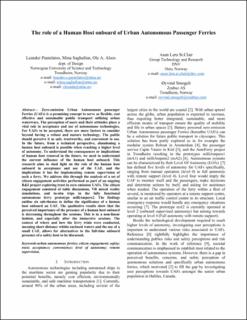| dc.contributor.author | Pantelatos, Leander Spyridon | |
| dc.contributor.author | Saghafian, Mina | |
| dc.contributor.author | Alsos, Ole Andreas | |
| dc.contributor.author | St. Clair, Asun Lera | |
| dc.contributor.author | Smogeli, Øyvind | |
| dc.date.accessioned | 2023-08-14T08:39:35Z | |
| dc.date.available | 2023-08-14T08:39:35Z | |
| dc.date.created | 2023-05-28T13:23:54Z | |
| dc.date.issued | 2023 | |
| dc.identifier.isbn | 978-1-68558-078-0 | |
| dc.identifier.uri | https://hdl.handle.net/11250/3083722 | |
| dc.description.abstract | Zero-emission Urban Autonomous passenger Ferries (UAFs) is a promising concept to serve as flexible, cost effective and sustainable public transport utilizing urban waterways. The perception of users and their attitudes plays a vital role in acceptance and use of autonomous technologies. For UAFs to be accepted, there are more factors to consider beyond having a robust and mature technology. The public should perceive it as safe, trustworthy, and convenient to use. In the future, from a technical perspective, abandoning a human host onboard is possible when reaching a higher level of autonomy. To understand the consequences or implications of human host removal in the future, we need to understand the current influence of the human host onboard. This research aims to shed light on the role of the human host onboard in acceptance and use of the UAF, and the implications it has for implementing remote supervision of such a ferry. We address this through the analysis of a set of citizen engagement activities performed as part of an ongoing R&I project exploring trust in zero emission UAFs. The citizen engagement consisted of table discussions, VR mixed reality simulations, and in-situ trips in the fully functional autonomous ferry prototype milliAmpere2. The findings outline six sub-themes to define the significance of a human host onboard an UAF. The qualitative results show that the perceived importance of the presence of a human host onboard is decreasing throughout the sessions. This is in a non-linear fashion, and especially after the immersive sessions. The context of where and how the ferry trials were conducted, meaning short distance within enclosed waters and the use of a small UAF, allows for alternatives to the full-time onboard presence of a safety host to be discussed. | en_US |
| dc.language.iso | eng | en_US |
| dc.publisher | International Academy, Research and Industry Association (IARIA) | en_US |
| dc.relation.ispartof | ACHI 2023: The Sixteenth International Conference on Advances in Computer-Human Interactions | |
| dc.title | The Role of a Human Host Onboard of Urban Autonomous Passenger Ferries | en_US |
| dc.title.alternative | The Role of a Human Host Onboard of Urban Autonomous Passenger Ferries | en_US |
| dc.type | Chapter | en_US |
| dc.description.version | acceptedVersion | en_US |
| dc.source.pagenumber | 213-221 | en_US |
| dc.identifier.cristin | 2149841 | |
| dc.relation.project | Norges forskningsråd: 331921 | en_US |
| dc.relation.project | Norges forskningsråd: 326676 | en_US |
| dc.relation.project | Norges forskningsråd: 309230 | en_US |
| dc.relation.project | Norges forskningsråd: 313921 | en_US |
| cristin.ispublished | true | |
| cristin.fulltext | original | |
| cristin.fulltext | postprint | |
| cristin.qualitycode | 1 | |
